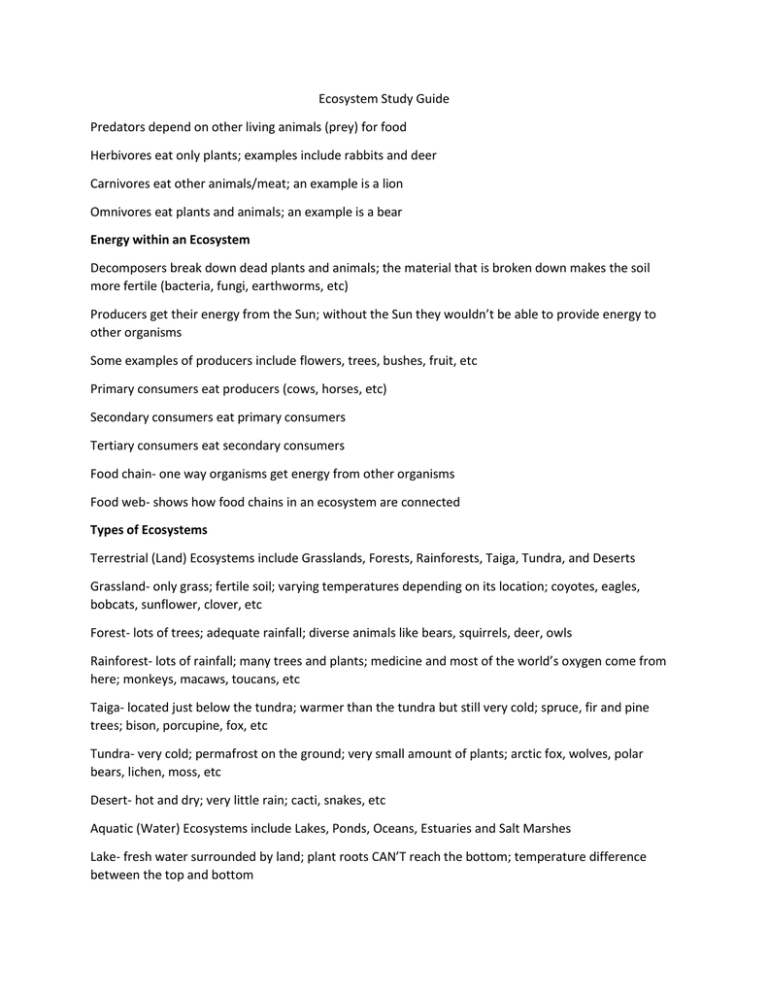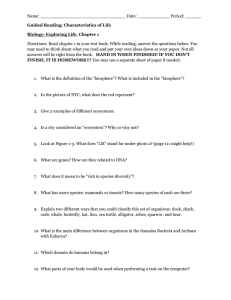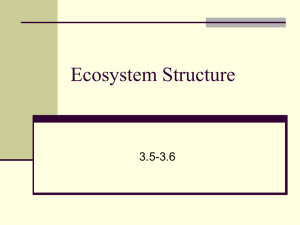Ecosystem Study Guide
advertisement

Ecosystem Study Guide Predators depend on other living animals (prey) for food Herbivores eat only plants; examples include rabbits and deer Carnivores eat other animals/meat; an example is a lion Omnivores eat plants and animals; an example is a bear Energy within an Ecosystem Decomposers break down dead plants and animals; the material that is broken down makes the soil more fertile (bacteria, fungi, earthworms, etc) Producers get their energy from the Sun; without the Sun they wouldn’t be able to provide energy to other organisms Some examples of producers include flowers, trees, bushes, fruit, etc Primary consumers eat producers (cows, horses, etc) Secondary consumers eat primary consumers Tertiary consumers eat secondary consumers Food chain- one way organisms get energy from other organisms Food web- shows how food chains in an ecosystem are connected Types of Ecosystems Terrestrial (Land) Ecosystems include Grasslands, Forests, Rainforests, Taiga, Tundra, and Deserts Grassland- only grass; fertile soil; varying temperatures depending on its location; coyotes, eagles, bobcats, sunflower, clover, etc Forest- lots of trees; adequate rainfall; diverse animals like bears, squirrels, deer, owls Rainforest- lots of rainfall; many trees and plants; medicine and most of the world’s oxygen come from here; monkeys, macaws, toucans, etc Taiga- located just below the tundra; warmer than the tundra but still very cold; spruce, fir and pine trees; bison, porcupine, fox, etc Tundra- very cold; permafrost on the ground; very small amount of plants; arctic fox, wolves, polar bears, lichen, moss, etc Desert- hot and dry; very little rain; cacti, snakes, etc Aquatic (Water) Ecosystems include Lakes, Ponds, Oceans, Estuaries and Salt Marshes Lake- fresh water surrounded by land; plant roots CAN’T reach the bottom; temperature difference between the top and bottom Pond- fresh water surrounded by land; plant roots CAN reach the bottom; temperature the same from the top to the bottom Ocean- covers most of the world; salt water Estuary- where fresh water and salt water meet; life is influenced by the rise and fall of tides; fish, shellfish, etc Salt Marsh- salt water; found near an estuary; crabs, fish, shrimp, etc Factors Impacting Other Organisms If one part of the food chain is dying out, it can impact other organisms. For example if a predator starts to decline, the prey it typically eats will start to increase because they are not being eaten Another example of this is if the population of a primary consumer starts decreasing, the producers it eats will increase If the producers in an ecosystem start to decline, it will impact the entire ecosystem because all of the energy in the food chain goes back to the producers; primary consumers won’t have anything to eat and then that impacts secondary consumers






